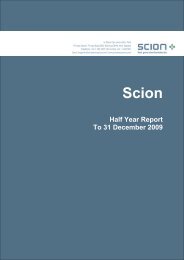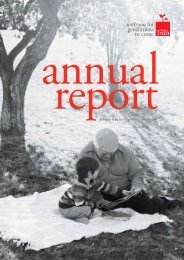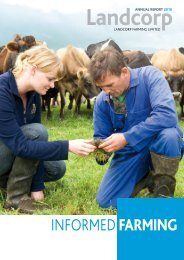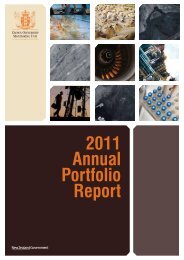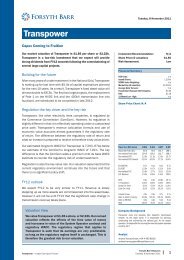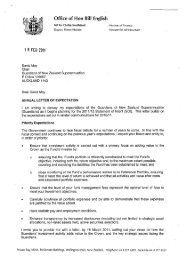MetService - Annual Report 2011 - Crown Ownership Monitoring Unit
MetService - Annual Report 2011 - Crown Ownership Monitoring Unit
MetService - Annual Report 2011 - Crown Ownership Monitoring Unit
You also want an ePaper? Increase the reach of your titles
YUMPU automatically turns print PDFs into web optimized ePapers that Google loves.
Financial statements<br />
Notes to the financial statements for the year ended 30 June <strong>2011</strong> (cont.)<br />
Goodwill and fair value adjustments arising on<br />
the acquisition of a foreign entity are treated<br />
as assets and liabilities of the foreign entity<br />
and translated at the closing rate.<br />
Financial instruments<br />
Financial instruments carried on the Balance<br />
Sheet include cash and cash equivalents,<br />
trade and other receivables, amounts owing<br />
to related parties, other financial assets, trade<br />
and other payables, Directors’ fees payable,<br />
employee entitlements, provision for dividend,<br />
derivative instruments and borrowings.<br />
Financial assets<br />
Financial assets are recognised and<br />
derecognised on trade date where the<br />
purchase or sale of an asset is under a<br />
contract whose terms require delivery of the<br />
investment within the timeframe established<br />
by the market concerned. Financial assets<br />
are initially measured at fair value, plus<br />
transaction costs, except for those financial<br />
assets classified as at fair value through profit<br />
or loss, which are initially measured at<br />
air value.<br />
Financial assets are classified into the<br />
following categories: financial assets at fair<br />
value through profit or loss (FVTPL),<br />
held-to-maturity investments, available-forsale<br />
(AFS) financial assets and loans and<br />
receivables. The classification depends on<br />
the nature and purpose of the financial assets<br />
and is determined at the time of initial<br />
recognition. The Group only holds financial<br />
assets categorised as financial asset at<br />
FVTPL or as loans and receivables.<br />
Effective interest method<br />
The effective interest method is a method of<br />
calculating the amortised cost of a financial<br />
asset or liability and of allocating interest<br />
income or expense over the relevant period.<br />
The effective interest rate is the rate that<br />
exactly discounts estimated future cash<br />
receipts or payments (including all fees on<br />
points paid or received that form an integral<br />
part of the effective interest rate, transaction<br />
costs and other premiums or discounts)<br />
through the expected life of the financial asset<br />
or liability, or, where appropriate, a shorter<br />
period to the net carrying amount of the<br />
financial asset or liability.<br />
Financial assets at FVTPL<br />
Financial assets are classified as at FVTPL<br />
where the financial asset is either held for<br />
trading or it is designated as at FVTPL. A<br />
financial asset is classified in this category<br />
if acquired principally for selling in the short<br />
term. Derivatives are also classified as held<br />
for trading.<br />
Financial assets at FVTPL are stated at fair<br />
value, with any resultant gain or loss<br />
recognised in the Statements of<br />
Comprehensive Income. The net gain or loss<br />
recognised incorporates any dividend or<br />
interest earned on the financial asset.<br />
Loans and receivables<br />
Trade receivables and other receivables that<br />
have fixed or determinable payments that are<br />
not quoted in an active market are classified<br />
as loans and receivables. Loans and<br />
receivables are measured at amortised cost<br />
using the effective interest method, less any<br />
impairment. Interest income is recognised by<br />
applying the effective interest method.<br />
Impairment of financial assets<br />
Financial assets, other than those at FVTPL,<br />
are assessed for indicators of impairment at<br />
each balance sheet date. Financial assets are<br />
impaired where there is objective evidence<br />
that, as a result of one or more events that<br />
occurred after the initial recognition of the<br />
financial asset, the estimated future cash<br />
flows of the investment have been reduced.<br />
For certain categories of financial assets, such<br />
as trade receivables, assets that are assessed<br />
not to be impaired individually are<br />
subsequently assessed for impairment on a<br />
collective basis. Objective evidence of<br />
impairment for a portfolio of receivables could<br />
include the Group’s past experience of<br />
collecting payments, an increase in the<br />
number of delayed payments in the portfolio<br />
past the average credit period, as well as<br />
observable changes in national or local<br />
economic conditions that correlate with<br />
default on receivables.<br />
For financial assets carried at amortised cost,<br />
the amount of the impairment is the<br />
difference between the asset’s carrying<br />
amount and the present value of estimated<br />
future cash flows, discounted at the financial<br />
asset’s original effective interest rate.<br />
The carrying amount of the financial asset is<br />
reduced by the impairment loss directly for all<br />
financial assets with the exception of trade<br />
receivables, where the carrying amount is<br />
reduced through the use of an allowance<br />
account. When a trade receivable is<br />
considered uncollectible, it is written off<br />
against the allowance account. Subsequent<br />
recoveries of amounts previously written off<br />
are credited against the allowance account.<br />
Changes in the carrying amount of the<br />
allowance account are recognised in the<br />
Statements of Comprehensive Income.<br />
If, in a subsequent period, the amount of the<br />
impairment loss decreases and the decrease<br />
can be related objectively to an event<br />
occurring after the impairment was<br />
recognised the reversal of the previously<br />
recognised impairment loss is recognised<br />
in the profit and loss component of the<br />
Statements of Comprehensive Income.<br />
Derecognition of financial assets<br />
The Group derecognises a financial asset only<br />
when the contractual rights to the cash flows<br />
from the asset expire or it transfers the<br />
financial asset and substantially all the risks<br />
and rewards of ownership of the asset to<br />
another entity. If the Group neither transfers<br />
nor retains substantially all the risks and<br />
rewards of ownership and continues to<br />
control the transferred asset, the Group<br />
recognises its retained interest in the asset<br />
and an associated liability for amounts it may<br />
have to pay. If the Group retains substantially<br />
all the risks and rewards of ownership of a<br />
transferred financial asset, the Group<br />
continues to recognise the financial asset and<br />
also recognises a collateralised borrowing for<br />
the proceeds received.<br />
Financial liabilities<br />
Financial liabilities are recognised and<br />
derecognised on trade date where the<br />
purchase or sale of liability is under a contract<br />
whose terms required delivery within the<br />
timeframe established by the market<br />
concerned.<br />
Classification<br />
Financial liabilities are classified as either<br />
financial liabilities at FVTPL or other<br />
financial liabilities.<br />
Financial liabilities at FVTPL<br />
Financial liabilities are classified as at FVTPL<br />
where the financial liability is either held for<br />
trading or it is designated as at FVTPL.<br />
Derivatives are also classified as held for<br />
trading. A financial liability is classified in this<br />
category if it has been incurred principally for<br />
the purpose of repurchasing in the short term.<br />
Financial liabilities at FVTPL are stated at fair<br />
value, with any resultant gain or loss recognised<br />
in the Statements of Comprehensive Income.<br />
The net gain or loss recognised incorporates<br />
any interest paid on the financial liability.<br />
30 Meteorological Service of New Zealand Ltd <strong>Annual</strong> <strong>Report</strong> <strong>2011</strong>



